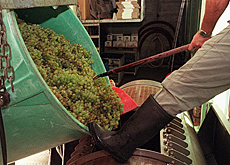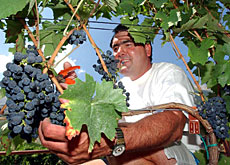Wood chips leave winemakers with bitter taste

Plans to allow the use of wood chips to flavour Swiss wines have uncorked a furious response from the country's winemakers.
They claim the arrival of “New World” practices will dilute the authenticity of the country’s centuries-old winemaking tradition and will also lead to confusion among consumers.
In March this year the European Union agreed to allow the addition of wood chips to wine after signing a landmark deal with the United States.
The Swiss, who are closely tied to Brussels via a series of bilateral accords, are now set to follow suit early next year.
Winemakers in the US, South America, South Africa and Australia have been adding wood chips to wines for a number of years to give them an oak flavour. The money-saving measure speeds the ageing process and cuts out the need for long and expensive storage in oak barrels.
But opponents in Switzerland fear the move will not only leave customers in a spin – an issue that has been seized upon by the Swiss Consumers Association – but also undermine the quality of native wines.
“Switzerland is a small winemaking region, only 15,000 hectares, and we need to remain a niche market with wines of a certain character. We don’t need to start producing wine on an industrial basis – we will lose quality,” Michel Duboux, president of the Association of Swiss Winemakers and Cellarmen, told swissinfo.
“What I fear most is that once we start allowing wood chips, the next step will be to allow flavouring. It’s like opening the floodgates and we are going to lose the authenticity of our wines.”
Regional heads of the association, which has more than 500 members, met on Thursday to unanimously condemn the practice.
Labelling
Both the Association of Swiss Winemakers and Cellarmen and the Consumers Association want wine made with wood chips to be clearly labelled.
But the Federal Health Office, which is already in the process of revising legislation, has come up with a different solution.
It intends to stipulate that wines that have been adulterated with wood chips cannot carry the label “aged in oak barrels”.
“The idea is not to allow wines to carry any mention of ‘aged in oak barrels’ if wood chips have been used,” said Pierre Studer, who is responsible for alcoholic beverages and water at the Health Office.
“I understand that in the US they make a difference between ‘aged in oak barrels’ and ‘oaked’, but we will not require any obligatory mention of this practice.”
Getting chippy
The Consumers Association, which is concerned that the public could be duped, is up in arms and wants the use of wood chips to be declared.
“There is no indication on wine bottles that oak chips are being used. But full transparency must be the highest priority for a natural product such as wine,” says the association on its website.
Monique Perrottet Richard, director of the Swiss Winegrowers Federation, takes a slightly more pragmatic view.
She says her organisation – which represents all the country’s winegrowing regions – is not opposed to the introduction of wood chips but says consumers need to be told clearly whether wines have been adulterated or not.
“I don’t think this will damage the authenticity of Swiss wines, but it is important to clearly communicate to the public what is going on and above all to differentiate between the two types of wine,” said Perrottet Richard.
“People need to know that wines made with wood chips do not age well compared with those made in oak barrels. There is a big difference in quality in terms of the final product.”
swissinfo, Adam Beaumont
Swiss wines regularly win top awards at international competitions, despite the fact that only one per cent of production (one million litres) is exported.
Following the liberalisation of the domestic market, a new generation of Swiss winemakers have been upgrading their vintages by lowering output, replanting vines and placing emphasis on regional grape specialities.
The Hachette Wine Guide 2005 – the French wine bible – awarded three stars for “exceptional” to 17 per cent of the 190 Swiss wines in the book. Only two per cent of French wines achieved the same rating.
Valais is Switzerland’s leading wine canton, followed by Vaud, Geneva and Ticino.
For the past decade, Swiss wines have made up 40% of the domestic market.
In 2003, for the first time ever, Swiss winemakers made more red than white wine.

In compliance with the JTI standards
More: SWI swissinfo.ch certified by the Journalism Trust Initiative

You can find an overview of ongoing debates with our journalists here. Please join us!
If you want to start a conversation about a topic raised in this article or want to report factual errors, email us at english@swissinfo.ch.